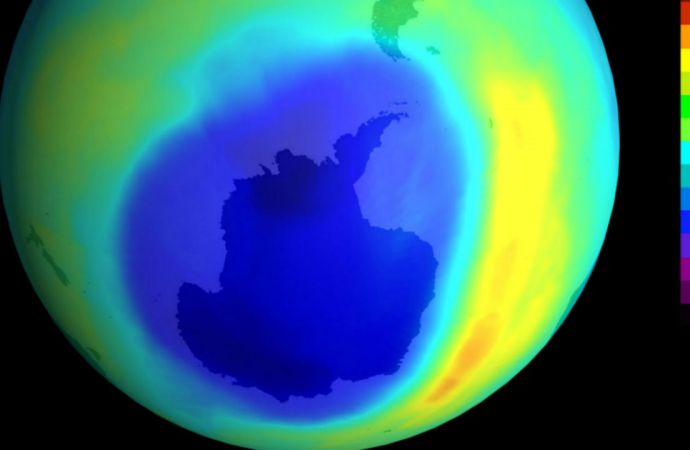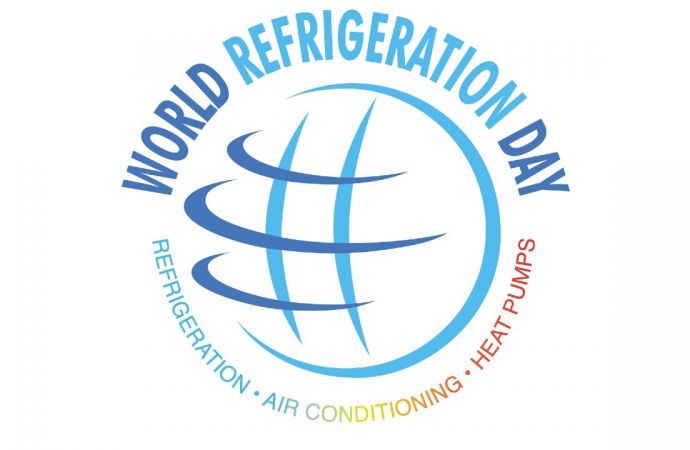The study – Quantifying contributions of chlorofluorocarbon banks to emissions and impacts on the ozone layer and climate – was published on March 17 at nature.com

The ozone hole is healing; image from NASA via Wikimedia Commons
A new study reports that emissions from unrecovered sources, or “banks,” of CFCs could delay the Antarctic ozone hole recovery by about six years and contribute 9 billion metric tons of CO2e between 2020 and 2100.
The study – Quantifying contributions of chlorofluorocarbon banks to emissions and impacts on the ozone layer and climate – was published on March 17 at nature.com. The authors include Megan Lickley, Susan Solomon, Sarah Fletcher, Guus J.M. Velders, John Daniel, Matthew Rigby, Stephen A. Montzka, Lambert J.M. Kuipers and Kane Stone.
“We find that bank sizes of CFC-11 and CFC-12 are larger than recent international scientific assessments suggested, and can account for much of current estimated CFC-11 and 12 emissions (with the exception of increased CFC-11 emissions after 2012),” the paper said.
The paper noted that the Montreal Protocol treaty, which phased out production and consumption of ozone-depleting substances (ODS), has become one of the “signature environmental success stories of the past century,” with signs that the ozone layer is beginning to recover.
However, CFCs were produced for use in refrigeration equipment and insulation foams, some of which have lifetimes of up to multiple decades, suggesting that “a bank of material could still exist, contributing to current and future CFC emissions,” the paper said.
The observation of unexpected CFC-11 emissions after the 2010 global production phaseout therefore “highlights the need for the best possible understanding of how much CFC remains in banks worldwide and how much banks are contributing to current emissions and their changes over time,” the paper noted.
Continuing emissions from remaining banks are not prohibited under the Montreal Protocol, but recovery and destruction of unneeded CFC banks “has been considered by policymakers as a means to both enhance ozone recovery and further safeguard the climate system as part of the Protocol.”
EIA response
The Environmental Investigation Agency (EIA), which has reported on illegal use of CFC-11, cited the study in calling for more aggressive destruction of CFC banks.
“This paper quantifies that we already lost the opportunity to prevent 25 billion metric tons of CO2e by not destroying CFC banks beginning in the year 2000,” said Avipsa Mahapatra, EIA’s Climate Campaign Lead, in a statement. “It would be unconscionable to repeat this mistake at a time our planet can ill afford. The climate crisis we are in today demands urgent global action ensuring that we search, reuse and destroy any of these potent gases before they leak into our atmosphere.”
Responding last year to what it called the lack of adequate action at the Montreal Protocol on addressing CFC banks, EIA’s U.S. branch published “Search, Reuse and Destroy: Initiating Global Discussion to Act.” The report called for “a comprehensive international framework accompanied by strong national regulations and sustainable financing mechanisms.”
The Nature study, added Mahapatra, “demonstrates that the Montreal Protocol can no longer turn a blind eye and must address the urgent unfinished business of dealing with the sources of these banks, including feedstocks, to ensure the complete recovery of our fragile ozone layer.”
The climate crisis we are in today demands urgent global action ensuring that we search, reuse and destroy any of these potent gases before they leak into our atmosphere." Avipsa Mahapatra, EIA
Related stories



